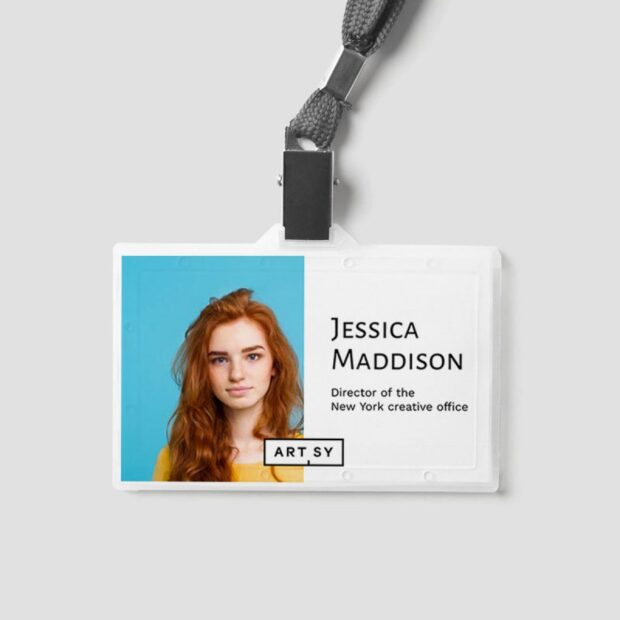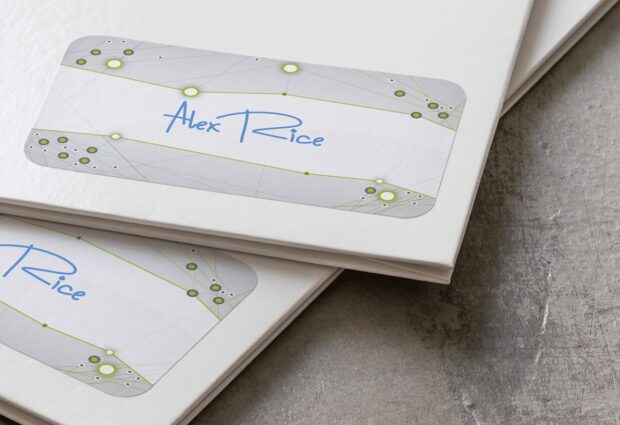In today’s dynamic business landscape, effective networking isn’t just a strategy—it’s a necessity. Establishing and cultivating relationships can be the difference between stagnation and growth. However, initiating conversations, especially with strangers, can be a challenging endeavor.
This is where the unsung hero of networking—the name tag—comes into play. More than a mere label, tags can be potent tools that catalyze conversations and build bridges between individuals. Throughout this post, we’ll journey through the multidimensional aspects of name tags, shedding light on their capability to unlock meaningful interactions in diverse settings.
The Psychology Behind Name Tags
It’s interesting how a small piece of material, adorned with a name, can pack such a psychological punch. At its core, a name tag is an invitation, an unspoken message saying, “Hey, you know my name, let’s talk!” When someone wears a tag, it becomes an extension of their identity, and it signals openness to others.
Humans, by nature, are creatures of habit and comfort. We gravitate towards familiarity and are more at ease when in known territories. The psychological comfort that name tags bring is rooted in this very essence of our nature. When we see a tag, the unfamiliar becomes familiar. That instant recognition can eliminate the initial moments of hesitation we often experience when meeting someone new. It is as if a virtual handshake is already extended, paving the way for a smoother interaction. Moreover, in a business context, where time is often of the essence, these saved moments can lead to more meaningful and productive exchanges.
Design Matters: Creating Engaging Name Tags

The effectiveness of a name tag is not merely in its existence but in its design. A well-designed tag can draw attention, invite curiosity, and even become a topic of conversation itself. Conversely, a poorly designed tag might remain unnoticed or even give a negative impression.
The choice of fonts, colors, and layouts isn’t just about aesthetics; it’s about communication. Bold, easily readable fonts are preferable over intricate, hard-to-decipher ones. Colors should be chosen not just for their visual appeal but for the emotions and energy they convey. A neon green might be eye-catching, but is it appropriate for a formal business conference? Probably not.
Layouts, too, play a pivotal role. A cluttered name tag can overwhelm, while a minimalistic one might underwhelm. Striking the right balance ensures the tag serves its primary purpose of displaying the while also providing any additional useful information. It’s an art and science of marrying functionality with aesthetics.
Customization for Connection
Personalizing a name tag does more than just display a name; it offers a glimpse into the person’s role, interests, or expertise. Customization can be as simple as name tags for work or as intricate as incorporating a hobby or personal quote. This added layer of information gives others more avenues to strike up a conversation.
Imagine walking into a business mixer and spotting a name tag that reads: “Jane Doe – Digital Marketing Enthusiast & Salsa Dancer.” This tag tells a brief story about Jane and offers multiple conversation entry points. Someone might connect with her professional expertise in digital marketing or bond over a shared love for salsa dancing. By going the extra mile in personalizing tags, businesses can foster deeper and more varied interactions among attendees or employees.
Icebreaker Questions on Name Tags

Enhancing name tags with conversation-starting questions is a game-changer. This ingenious tweak transforms the tag from a passive identifier to an active engagement tool. Questions like, “What’s a book you’re currently reading?” or “What’s your favorite travel destination?” can ignite discussions, share experiences, and bridge differences.
By integrating these icebreakers, you offer attendees a toolkit for networking. It can be especially beneficial in settings where individuals might feel out of their depth or unsure of how to initiate conversations. With a prompt readily available, the usual networking jitters can be replaced with enthusiastic dialogues.
Interactive Tags
In the age of technology, name tags have evolved beyond paper and plastic. Today, we have the means to create interactive badges that can engage people in unique, memorable ways. Consider tags integrated with QR codes that, when scanned, lead to a personal portfolio or LinkedIn profile. Or perhaps a badge embedded with NFC technology that exchanges contact information with a simple tap.
Such interactive tags not only streamline networking by providing instant access to comprehensive information but also serve as remarkable conversation starters. “Oh, your badge has a QR code? That’s cool! Can I scan it?” becomes a gateway to more in-depth interactions.
Using Tags at Conferences and Events

Conferences and events are bustling arenas of potential connections. However, the sheer volume of attendees can sometimes dilute the quality of interactions. Name tags, in such settings, act as beacons, guiding individuals toward meaningful conversations.
Businesses that have effectively harnessed the power of name tags in such settings often report enhanced attendee satisfaction. For instance, a tech symposium using interactive badges found attendees were 30% more likely to follow up on connections made during the event. By facilitating initial interactions, tags can lay the groundwork for lasting professional relationships.
Name Tags in the Retail Environment
Retail settings present a unique opportunity for fostering customer interactions through name tags. Imagine entering a store and being greeted by an employee whose tag reads: “Liam – Your Tech Guru for Today!” Such personal touches can instantly make customers feel more connected and valued.
For retail businesses, name tags aren’t merely identifiers; they’re branding and trust-building tools. They help demystify the commercial environment and make it feel more intimate. An approachable staff member, identifiable by their name and role, can be the difference between a one-time shopper and a loyal customer. It offers customers an immediate point of contact and can facilitate smoother service interactions.
Employee Tags for Better Customer Service

In customer service, first impressions matter. And oftentimes, that first impression is formed the moment a customer reads an employee’s tag. Beyond identification, name tags can communicate professionalism, approachability, and brand alignment.
Training staff to maximize the potential of their name tags can amplify their effectiveness. Simple techniques, such as referring to themselves by name during introductions (“Hi, I’m Sarah, as my tag says!”) or pointing out specific elements of their tag (“I’m the in-house coffee enthusiast, as you might have noticed!”), can foster a more personalized service experience.
Online and Virtual Networking with Name Tags
The digital realm is not to be left behind in the name-tag evolution. Virtual events and webinars have surged in popularity, and with them comes the need for digital introductions. Digital tags, appearing as overlays on video feeds or as profile badges in chat rooms, offer the same benefits as their physical counterparts, albeit in a virtual environment.
Platforms like Zoom or Microsoft Teams have features that allow users to customize their display names, making them perfect for digital tagging. Incorporating titles, company names, or even emojis can provide context, personality, and conversation starters in online settings.
Measuring the Impact of Name Tags

The utility of any tool, name tags included, should ideally be backed by data. To understand the impact of tags as conversation starters, businesses can employ feedback surveys post-events or monitor social media mentions and interactions. Metrics such as “number of connections made,” “follow-up interactions,” or even qualitative data like “most memorable interactions” can provide invaluable insights.
Regularly collecting and analyzing this feedback can guide businesses in refining their name-tag strategies, ensuring they remain effective and relevant in an ever-evolving networking landscape.




























